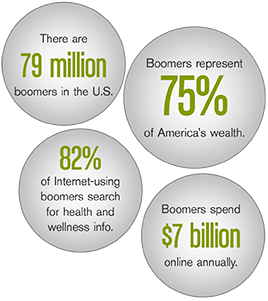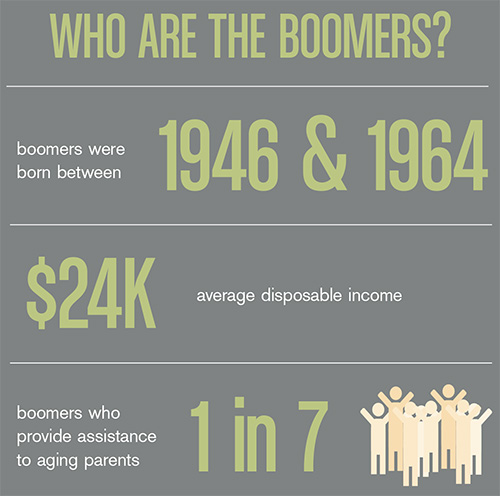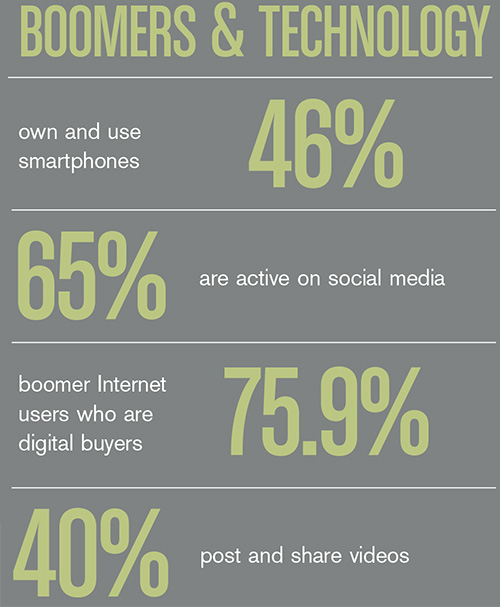There are 79 million baby boomers in the U.S. alone, and each year this demographic spends more money on goods and services than any other age group. The estimated total in 2005: $2 trillion annually. In fact, baby boomers account for nearly $230 billion, or 55 percent, of consumer packaged goods sales. According to Jupiter Research, boomers also represent the Web's largest constituency. Forty-six percent own and use smartphones, and 65 percent are very active in social media. In fact, they own more iPads and smartphones than any other demographic. American Life Project states that 82 percent of baby boomers using the Internet search for health and wellness information online. Those caring for aging parents spend 150 minutes per person each month viewing 1,010 pages of content—70 percent more than the average user. They also figure heavily into online shopping statistics, making at least one online purchase per month. They spend nearly $7 billion online per year, representing 49 percent of total online sales. Do you still think your buyers are not online?

According to the U.S. Government Expenditure Survey, baby boomers have, on average, $24,000 in disposable income. This group has the money and the will to spend. They grew up with TV advertising and infomercials. They are big spenders and are not averse to advertising. When marketing to this generation, there are a few things to which business owners need to pay attention. Boomers, also known as the sandwich generation, often spend time between grandchildren and aging parents. About one in seven middle-age adults provides financial support to both a parent and a child. When it comes to purchasing decisions for their aging parents, they will not think twice about buying a product if it will bring comfort to the parent and freedom to themselves. Boomers are decision makers and favor convenience above price. In fact, boomers don't tend to pay a lot of attention when it comes to discounts or coupons. They value their time too much, and they favor quality and convenience even more. It is important, however, to understand that they value freedom most of all. Boomers are at a time in their lives when they really don't want to compromise their authenticity. This generation does not like to be put in a box, and they don't like to be compared with other generations. They are proud of having reinvented every stage of their own lives and are a rebellious group. The marketing message needs to be very specific to them.

The worst marketing move one can make is to call them old, discuss age, talk to them as though they are seniors, focus on diseases, try any type of fear-based selling or not direct the message right to them. Boomers are powerful consumers, but they also feel invisible when it comes to marketing. The sad truth is that most marketing agencies still follow a 30-year-old mentality that people above the age of 50 are not decision makers and therefore are not power consumers. This could not be further from the truth. Boomers are called the "me generation" for a reason. They dislike feeling trapped, conned, boxed-in, put upon by arbitrary power or thought of as one of the masses. Remember that the baby boomers want to reinvent old age. They have a lot of energy and drive to stay alive and active. This is a generation who wants to live forever. They don't get old or retire; they mature and live to leave a legacy. They don't age; they are in a particular life stage. They want to be cool as grandparents and they want the best for their aging parents. They want to be there for their parents no matter the cost. Talk to them about possibilities, and you will be on the right track. Language and relevancy are extremely important when marketing to boomers. Your message needs to matter to them on an emotional level. Don't focus on features and benefits; focus on talking to the heart. This crowd is a little self-centered. Talk right to them and don't forget to talk to what they value the most. Make big, emotional promises. Help them feel helpful. Accentuate personal style.

In its recent list, Top 10 Consumer Trends, trendwatching.com identified several trends that closely match with boomer preferences. These include a need for companies to be transparent and honest about their efforts to conduct environmentally sustainable business practices and genuinely collaborate with their customers rather than try to dictate to them. In addition, consumers are increasingly using social networks as part of everyday life, and they respond well to products and services which have a charitable component. When marketing to baby boomers online, the top places to be are Google, YouTube, Facebook and Yahoo. Facebook and YouTube rank high on the list of favorite sites, putting them on par with their 18- to 34-year-old counterparts. Boomers are very used to the play button, so don't discount online videos with relevant information. Although they are not as big on sharing things online when compared to millennials, they love to add videos to their own Facebook timelines. In fact, 40 percent of boomers post and share videos. Remember that, in marketing strategy, attention equals gold—but attention is difficult to get. Visibility is worth nothing if people are not paying attention. When crafting marketing messages to boomers, keep in mind that this is an overwhelmed crowd with an average attention span of just 9 seconds (the same as a goldfish), so don't waste time talking about how great your products are. Be relevant, become a storyteller and talk to the heart.
